Eager to know how to style and layout a living dining room so it flows and functions beautifully? I have all the tips you need to furnish your open plan space at home just right.
Most of us have an open plan living and dining room these days. They’re par for the course in modern homes. But all too often I see a number of mistakes being made, with so many of my design clients not knowing how to correct them.
Often these mistakes are visual, style mistakes (like the wrong colours or patterns or furniture shapes). But then there’s also a number of open plan functional issues at play that make your living and dining room harder to use day-to-day.
If you’re nodding along to a lot of what I’m saying, this post is going to sort you out. Below I’m sharing all of my open plan living and dining room design tips, furniture advice and layout hacks to make this zone of your home a stunner.

1. Don’t Wedge Furniture Against Walls
So many of the open plan living and dining rooms I go into feel like kids at a school disco. You know, all the boys on one side and all the girls on the other with a great whopping gap in the middle?
All too often people feel compelled to push sofas right up against the wall when they don’t need to. Give them a little breathing room, especially if the space in question is large. Pulling them off the wall 10 to 20cm gives a sense of more room and airiness, which can make the zone feel more welcoming.
This is particularly important when it comes to sofas and windows. If your space is big enough, leave a good 60cm gap behind your sofa, between it and a window. People often worry about furniture cutting across a window. But if you give it a larger gap, it feels more intentional and refined.
2. Create Walkable Paths Around the Space
I see dining tables wedged against the wall a lot, because people feel they need a massive walkway on one side of it to get to another area of the home. This is an open plan layout rookier error if I ever saw one.
Ideally, in any room, you want to create pathways. You place furniture in the middle of the space to essential direct traffic. It tells you (and others in the home) how to move in and around the space. With this in mind, it’s perfectly acceptable (and the best layout option, actually) to have the dining table in the middle of the room with a walkway around it.
You want to be able to fully move around your table on all sides. If this is impossible, it’s usually because the table is too big for the room. If that’s the case, I say it’s better to admit your mistake and buy a smaller table. Let it claim its rightful place in the dining room, with space to pull out chairs.
If your dining room is tight on space, check out this post on how to style a smaller dining room.

3. Keep the Sofa Open to the Other Rooms
We’re talking ideal scenarios here when it comes to the best layout for open plan living dining rooms. Each of us has our own unique space to furnish with its own challenges. But if you can apply this rule, it’s a good one to follow.
The dream is that you can sit on your sofa and talk to someone sitting at the dining table (or in the kitchen). You want to orient the sofa in such a way that it doesn’t completely cut across the room, so people in the kitchen and dining are looking at your back.
You’re better off having a sectional sofa with its back running across two walls, and then having an armchair across from it, with its back to the dining and kitchen. This also keeps the path into the living room open, rather than having a long run of sofa preventing you from entering the space.
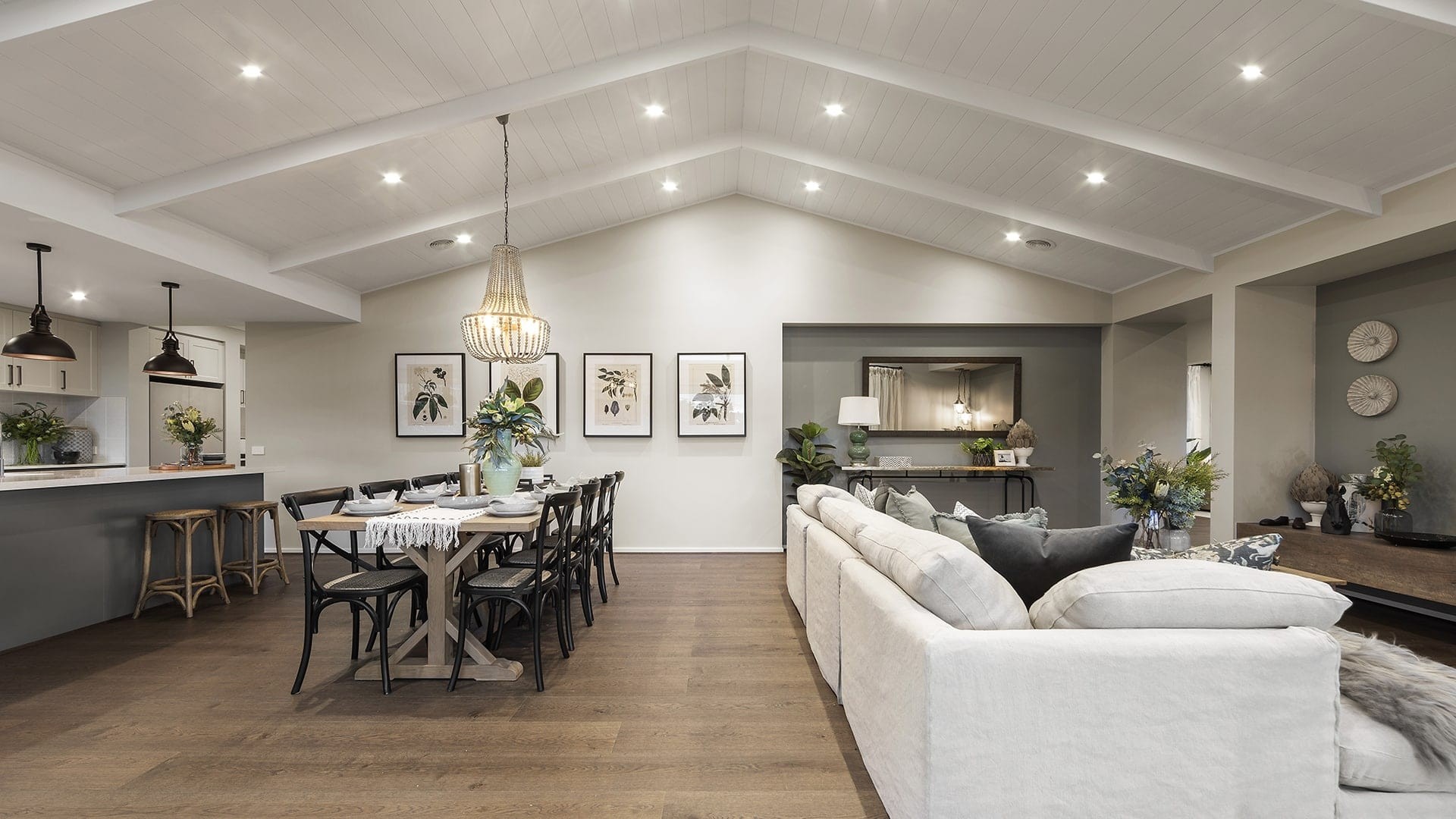
4. Low-Back Furniture is an Open Plan Saviour
I know it’s not always possible to follow rule three above, with the sofa back sitting against a wall in an open plan room, looking across to a dining room and kitchen. If you’re in this situation, there are some workarounds.
If you need to position the sofa with its back to the other rooms (essentially cutting off the room, so to speak) it’s crucial the sofa back is low. This will keep the space feeling as airy and open and it possibly can.
This means high-back recliner chairs are a no-no, unless you can find another wall to put them against in the room. Large puffy sectional sofas are also off the cards. I promise you both styles of furniture and their high backs will make your room feel a thousand times smaller, so avoid if you can.
While we’re on the subject, good-looking recliners with modern profiles do exist in this post if you’re on the hunt.

5. Define One of the Zones with a Rug
A lot of open plan living and dining rooms feel like one giant hall. Nothing apart from the sofa and dining table says that one zone is for lounging in, and one is for dining in. This is because the two zones haven’t been grounded by anything. Nothing says “this is one room, and over there is another”.
That’s not to say you want to make the rooms separate. After all, the whole point of an open plan space is that you can seamlessly go from one to the other. But you do want to give them their own anchor.
A rug is the easiest way to do this in the living room. It’ll place an obvious border around part of the room to define it as its own zone. Depending on the size of your open plan living and dining room, you might want to put a rug under your dining table too.
Just be careful in a small space where your living room rug would be a metre or so from your dining table. In a scenario like this, just rug the living room and leave the dining room along.
Here’s all my advice on choosing the right rug for your space.
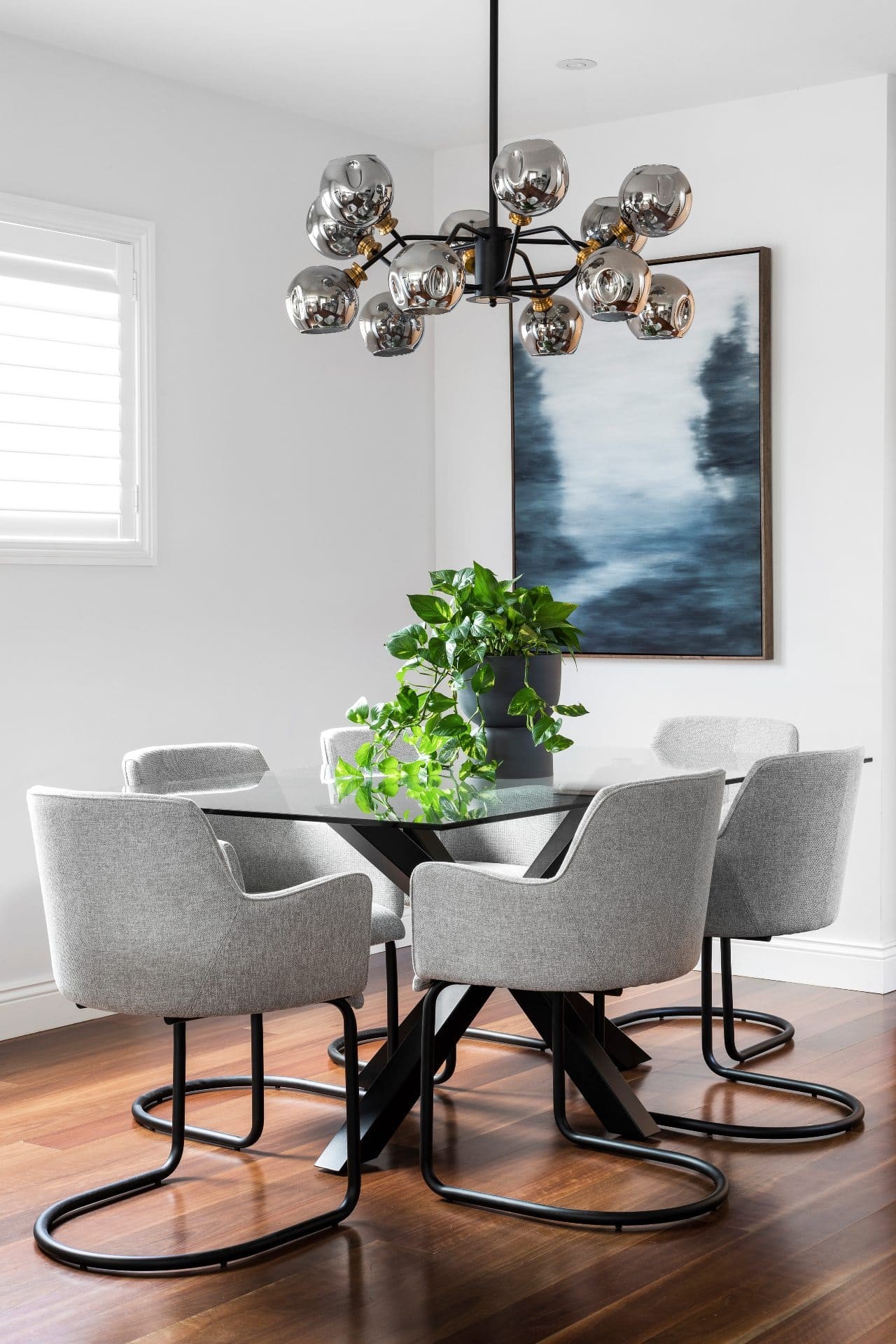
6. Pendant Lights Also Help with Zoning
In small homes, you might not have the space to lay out large area rugs to zone your open plan living and dining rooms. Or, as a reader has stated in the comments below, mobility issues may mean rugs become trip hazards. If you can I always say a rug in a living room is crucial. But pendant lights work too.
Pulling your dining table off the wall and installing a pendant light above it does wonders for a few reasons. Firstly, it gives you the necessary path around the table, but it also stops it from being apologetic. The pendant light above the table marks it as a true design destination. It claims its rightful place!
I’d not ever suggest a pendant above a dining table and in the living room unless the open plan space is particularly large. In most cases, rug the living room, pendant light the dining room, and both spaces will feel adequately zones and grounded.
Here’s my top ideas for pendant lights above dining tables.
7. Ensure the Zones ‘Speak’ to Each Other
Open plan living and dining rooms that sit side by side are like brother and sister. If there’s a kitchen thrown in too, then it’s like three kids from the same family. They look a little similar, but they’re not twins.
That’s how you should approach the furniture and decor in your open plan zones. You need elements in each room to speak to one another, but not feel too forced.
For example, your leather dining chairs might speak to the leather cushions you have on your sofa. You might have an armchair in your living room in a colour that is reflected in your dining room artwork. Or maybe it’s a pendant light over your dining table, with some brass moments that are picked up in the legs of your coffee tables in the living room nearby.
I’m sure you get the idea here. You want small elements in the two zones to be the same colour or material, so the open plan living and dining room feels cohesive and connected.
8. That Said, Avoid Going too Matchy-Matchy
Of course, things can go the other way quite easily with dire results. And by that I mean, furniture can match too much. You have to be careful here with colours and materials.
The last thing you want to do in an open plan living dining room have an entire set of furniture from the one store that all matches perfectly. The days of package deals are over: you heard it here first.
If you have a dining table, dining chairs, coffee table, side tables, sideboard and an entertainment unit all in the same material, it’s creates a huge amount of visual overwhelm. You need more variety in your colours and materials. The rooms should make sense side by side but by no means should furniture all come from the same range.
Instead, think of an overall interior design style you want to the rooms, and select furniture from different stores.
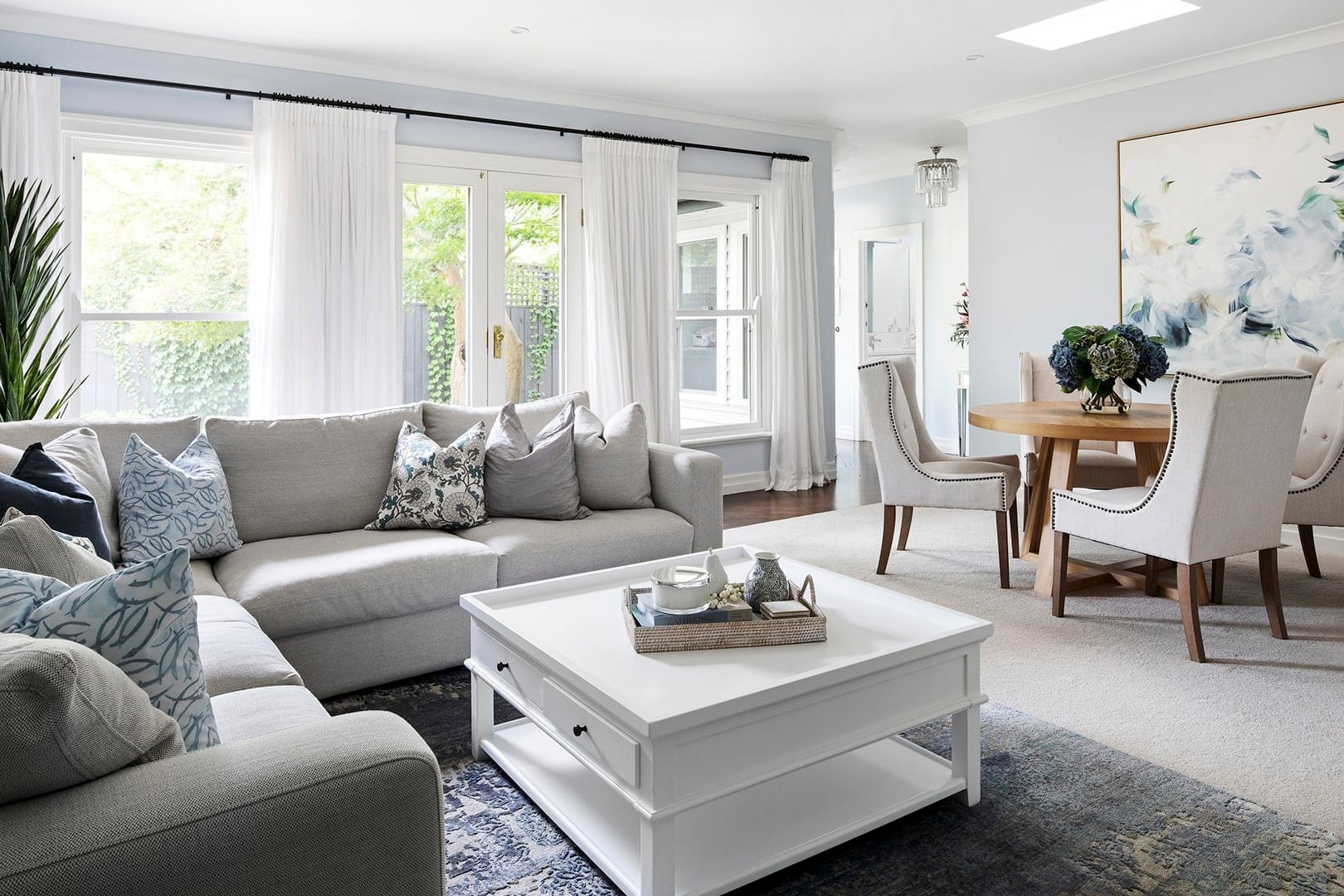
9. Ensure Furniture Shapes are Varied Too
We know we want a variety of colour and materials in furniture for an open plan living and dining room. But the shapes of furniture are important too.
Every hear someone refer to a room with a lot of ‘clean lines’? What they mean is, the space has a lot of furniture that’s square or rectangle in profile, as opposed to fluid lines or shapes, like ovals or circles. In your open plan room, you need a combination of both clean lines and fluid shapes.
This is really important in a smaller space, where the dining and living run alongside one another and the furniture is quite close. In this scenario, you want a rectangle dining table and round coffee table. Or, an oval dining table and a square coffee table.
You can get away with a square coffee table and a rectangle dining table in a larger open plan living dining room. Some images in this post will show you how it’s done. But in smaller spaces I definitely recommended a combination of shapes.

10. Embrace Some Negative Space
We’ve moved toward open plan living and dining rooms in modern homes because of of the airy, open feel they create. We’ve moved away from multiple rooms being closed off from one another. We’ve removed a lot of the walls to let light into our spaces. So you need to ensure you embrace some of that space, particularly negative space.
By that I mean, know when you’re cramming too much furniture into the room. Not every wall needs furniture on it. Sometimes the room isn’t large enough to take it. Sometimes you’re better off having a wall with a large mirror on it, or piece of statement art that gives the space a focal point without taking up much of the room’s footprint.
Scale of Furniture is Also Key
You want to be able to walk from the dining room to the living room without scraping against furniture, so scale is also key. Remember, furniture needs to breathe, pulled off a wall, with space around it. Always allocate for walkway around pieces when you’re planning your furniture layout.
One of the worst things you can do in an open plan living and dining room is have massive, chunky furniture that makes the whole zone feel as closed off as it would if it had walls put back up in it. Always think about your eye gliding over furniture to see beyond it, out the window or door.
What Issues Have you Faced?
I’d love you to share some of the issues you’ve faced in your open plan living and dining room layout. What trouble did you get into, and how did you overcome it? Share away in the comments below so other readers can soak up your pearls of wisdom.
Oh, and if you have any style questions regarding your own open plan living and dining room, drop me a comment below.
This post includes images and/or videos of Metricon display homes and events, reproduced with permission. © Metricon Homes Pty Ltd 2021.


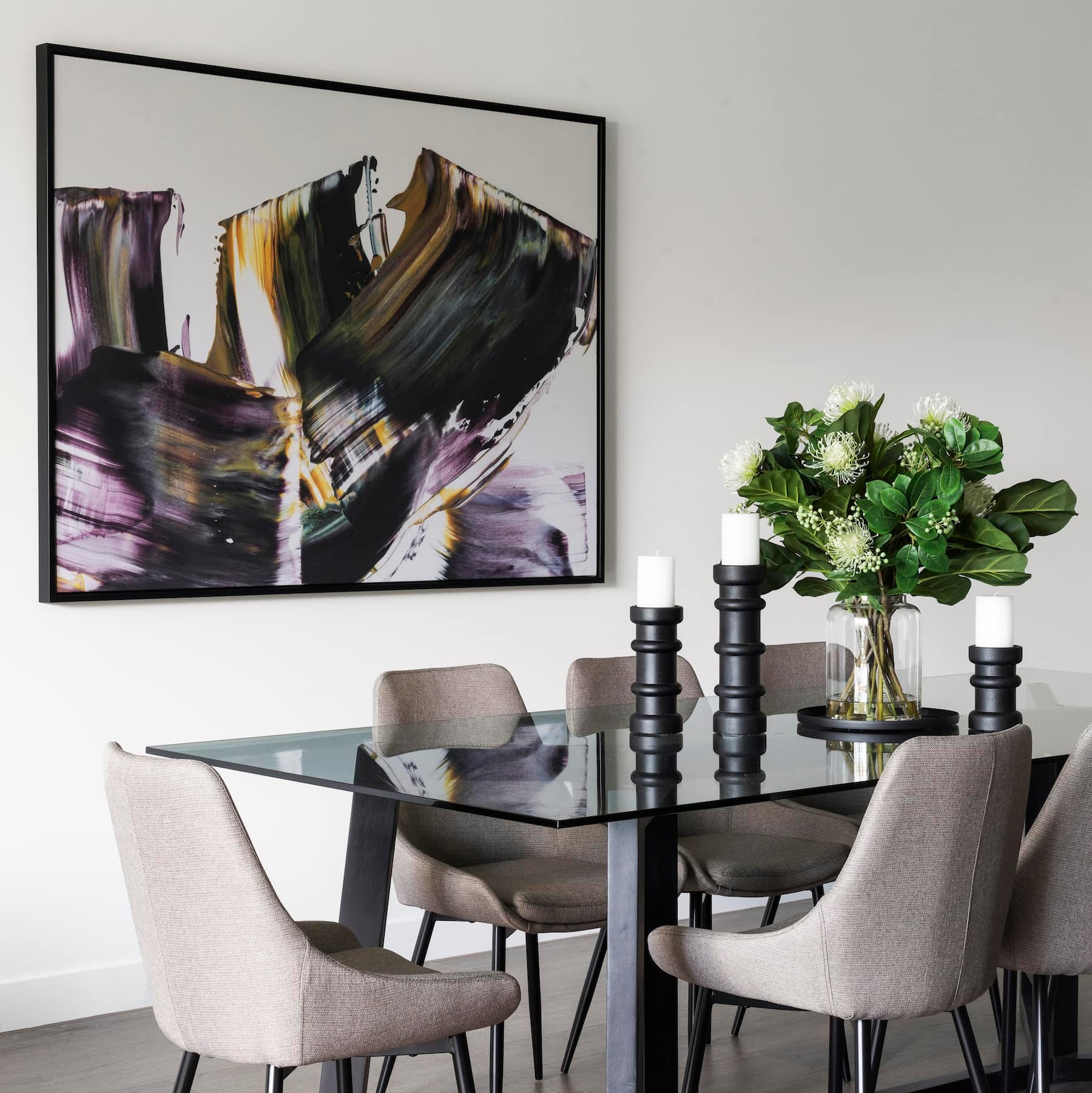


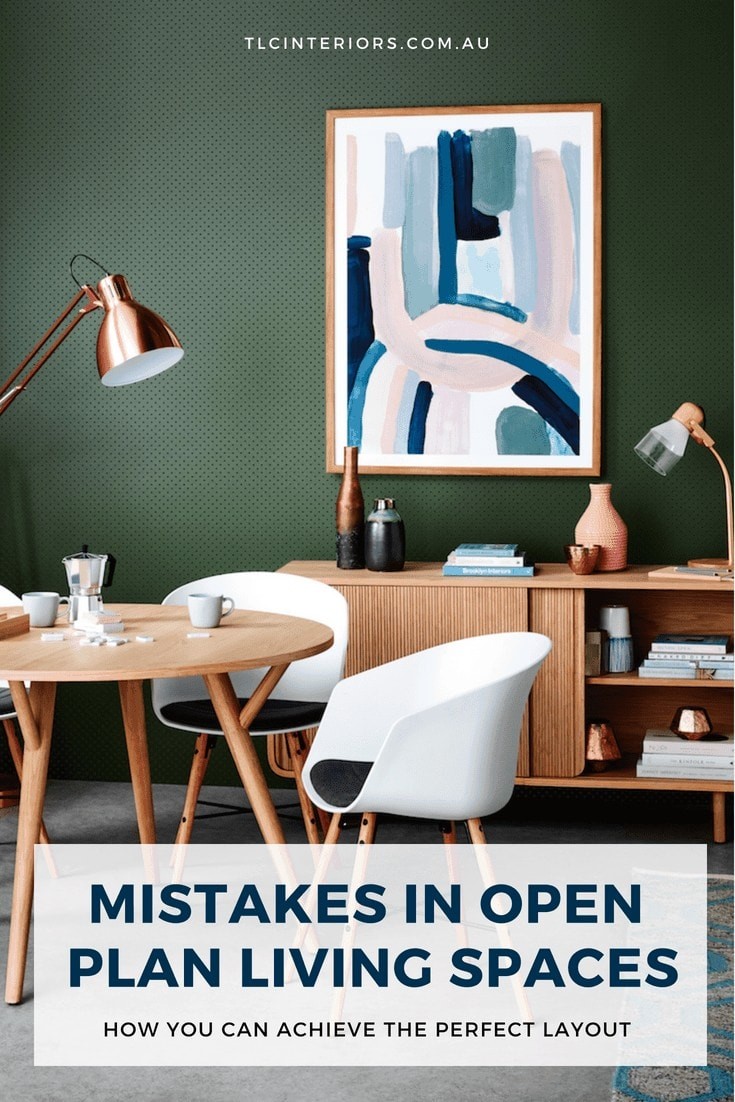


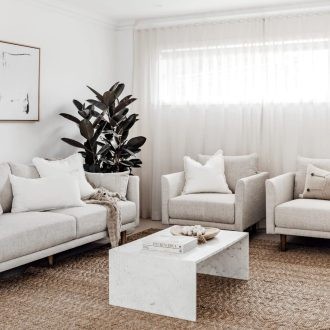
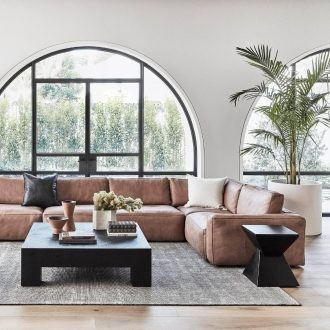





49 Responses
great article, i was worrying about the strange layout of the dining room and I didn’t know if I could pull off putting the sofa back to the dining table.
I have a large open plan living and dining. I’ve been one to always think sofa against wall, art above sofa etc, but after reading this article I’ve moved my sofa 60 cm off the wall and now I have a walkway behind sofa and feel it looks more cohesive. Great article.
That’s so great to hear Debbie. Glad you’re loving the new vibe! 🙂
We have a small room 4.3w x 5.7D to the island bench which we want two stools under. We need to fit a lounge and dining table in that space . We are thinking about a small round glass dining table 1.2 and not sure about the lounge type – chaise or no chase. The lounge and dining table must be on the same wall as tv unit on the other wall. Thanks Shellie
Probably no chaise from how you’ve described it.
I have two leather couches facing each other and a chunky heavy coffee table. Great open space . I NEED HELP !!!! I need a second pair of eyes to create a NEW concept that goes with the rest of the space.
I have a large, open plan living area in our apartment that encompasses kitchen with scullery, dining and living room. My problem is accessories. So a plant on the buffet, and a vase on the dining room table, and a vase under the mirror in the living area. Suddenly I look around and realise I have what to me looks like a florist store on every available surface and I hate it! But no way am I going to put say, a statue in the middle of a dining room table… I have just run out of ideas for making it homey yet not looking like I’m a shop where all these things are for sale!
Hi Chris
I don’t watch The Block but love all your critiques.
We are moving into a new apartment off the plan and open plan) Am planning on having dining table with bench seat on one side near the wall and chairs on other side. In time I would like to replace bench seat with a built in banquette. You didn’t mention this type of set up do you think it can work in a small space??
Love your advice Chris.. Just signed to followed your FB page..
Hi Chris,
I just came across your article (and fb group!)
I’m just starting to style our new place, and I’m stuck on the woods matching/colours.
I don’t even really have a “theme” per se!
(Open plan living dining) I have a lovely leather brown couch, and a wood + metal black leg coffee table. Dining table is a different hard wood with velvet green chairs + black legs.
My question is – is a wood buffet unit too much? Should I incorporate white buffet or TV unit?
Ta!
Hi Alicia, sorry the team and I don’t have the capacity to offer individual advice on the blog. Post your question and pictures in the FB group.